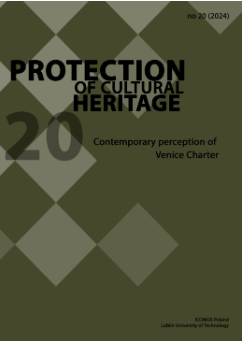Venice Charter and the Development of Authenticity
Abstract
Authenticity has been a concern for many centuries. In the 19th century, during the restoration interventions on Notre Dame, it was obvious that authenticity was linked solely to the original material of the monument. It was in the Venice Charter of 1964, that there was an attempt to define authenticity. Since then, the perception and understanding of what is authentic has changed. This shift in meaning is partly due to changes in the sanctioned definitions of chartered documents, which influenced the values society attributed to their heritage. Values counteracted this by becoming wider in scope. Though the Venice Charter mentioned authenticity, it did not specify the attributes heritage should maintain to be considered authentic. This was to change when intangible and tangible heritage were considered as criteria for inscription in World Heritage Sites, particularly with the pivotal contribution from the Japanese experience of intangible heritage when they joined the World Heritage Convention. Once intangible and tangible heritage were considered for inscription in World Heritage Sites, authenticity was pushed to consider other attributes than materiality alone. The understanding of authenticity was developed through discussions regarding World Heritage Sites like Abu Simbel, the Historic Centre of Warsaw and Mostar Bridge, which were enlisted as World Heritage Sites after major interventions or reconstruction works were carried out on them. The article concludes with a discussion regarding how the characteristics of the material used, in particular in a case of reconstruction, could influence the authentic or truthful experience of a historic site.Keywords:
authenticity, material, Outstanding Universal Value, World Heritage SitesReferences
Carbonara, Giovanni& Pergoli Campanelli, Alessandro. “Dell Restauro del Tempio-Duomo di Pozzuoli” Restauro 35-36. 2010. https://documen.site/download/tempio-cattedrale-a-pozzuoli-10-alessandro-pergoli-campanelli_pdf.
Google Scholar
Denslagen, W. (1994) Architectural Restoration in Western Europe: controversy and continuity Amsterdam: Architectura & Nature Press.
Google Scholar
Denslagen, W. (2009). Romantic Modernism nostalgia in the world of Conservation. Amsterdam: Amsterdam University Press.
Google Scholar
Dezzi Bardeschi, Marco. N/A Tempio Duomo Rione Terra. http://www.marcodezzibardeschi.com/_Progetti/incorso/Tempio_Duomo.html
Google Scholar
Earl, J. (2003). Building Conservation Philosophy. Shaftesbury: Donhead.
Google Scholar
ICOMOS (1964). International Charter for the Conservation and Restoration of Monuments and Sites. (The Venice Charter 1964) https://www.icomos.org/en/participer/179-articles-en-francais/ressources/charters-and-standards/157-thevenice-charter.
Google Scholar
ICOMOS (1994) The Nara Document on Authenticity. https://www.icomos.org/en/charters-and-texts/179-articles-en-francais/ressources/charters-and-standards/386-the-nara-document-on-authenticity-1994.
Google Scholar
ICOMOS, (1931) The Athens Charter for the Restoration of Historic Monuments – 1931. https://www.icomos.org/en/167-the-athens-charter-for-the-restoration-of-historic-monuments.
Google Scholar
ICOMOS, (n/d) Berg, L. The Salvage of the Abu Simbel Temples. https://www.icomos.org/public/monumentum/vol17/vol17_2.pdf.
Google Scholar
Jokilehto, J. (1999). A History of Architectural Conservation. Oxford, England: Butterworth-Heinemann.
Google Scholar
Kiniry L. (2018) Egypt’s exquisite temples that had to be moved. https://www.bbc.com/travel/article/20180409-egypts-exquisite-temples-that-had-to-be-moved.
Google Scholar
Madrid Conference (1904) Sixth International Congress of Architects, https://docslib.org/doc/4463614/recommendations-of-the-madrid-conference-1904-sixth-international-congress-of-architects.
Google Scholar
Mehr, S. (2019) Analysis of 19th and 20th Century Conservation Key Theories in Relation to Contemporary Adaptive Reuse of Heritage Buildings. Heritage. DOI:10.3390/heritage2010061.
Google Scholar
Munoz Vinas, S. (2023) A theory of Cultural Heritage. Beyond the intangible. Oxforshire, UK, Routledge.
Google Scholar
Ruskin, J. 1989, The Seven Lamps of Architeture. Dover Publications.
Google Scholar
Stovel, H (2008) Origins and influence of the Nara document on Authenticity. APT Bulletin 39 (2/3): 9-17. https://www.iccrom.org/sites/default/files/publications/2020-05/convern8_01_hstovel_ing.pdf.
Google Scholar
UNESCO. (n/d). Historic Centre of Warsaw. https://whc.unesco.org/en/list/30/.
Google Scholar
UNESCO. (1980). Operational Guidelines for the implementation of the World Heritage Convention. https://whc.unesco.org/archive/opguide80.pdf.
Google Scholar
UNESCO. (2005). Operational Guidelines for the implementation of the World Heritage Convention. https://whc.unesco.org/archive/opguide05-en.pdf.
Google Scholar
UNESCO. (n/d). Old Bridge Area of the Old City of Mostar. https://whc.unesco.org/en/list/946/.
Google Scholar
UNESCO. Nubian Monuments form Abu Simbel to Philae, https://whc.unesco.org/en/list/88/.
Google Scholar
UNESCO. World Heritage Convention. https://whc.unesco.org/en/convention/.
Google Scholar
UNESCO. Intangible Cultural Heritage. https://www.ichgovernance.com.
Google Scholar
Statistics
Abstract views: 47PDF downloads: 66









